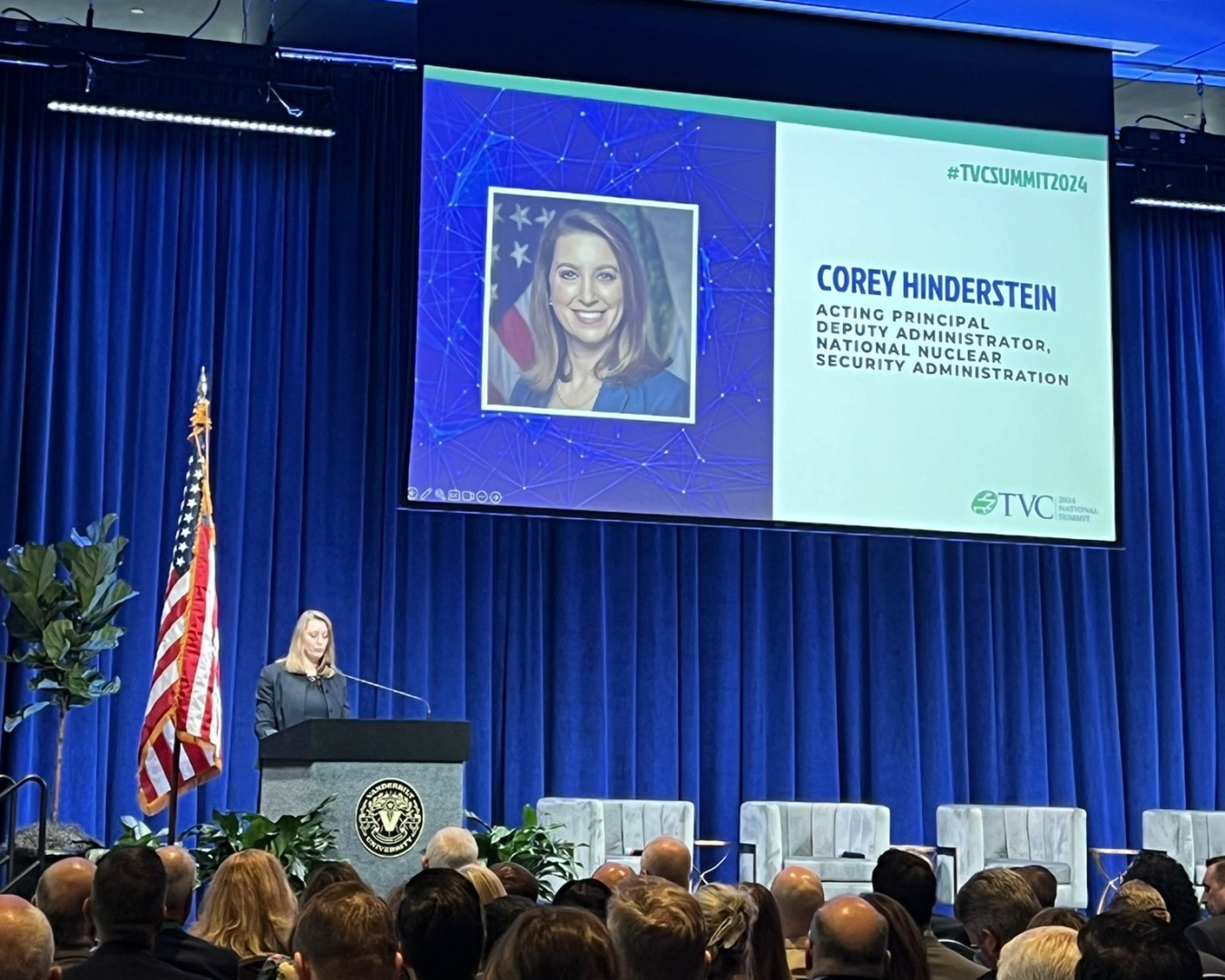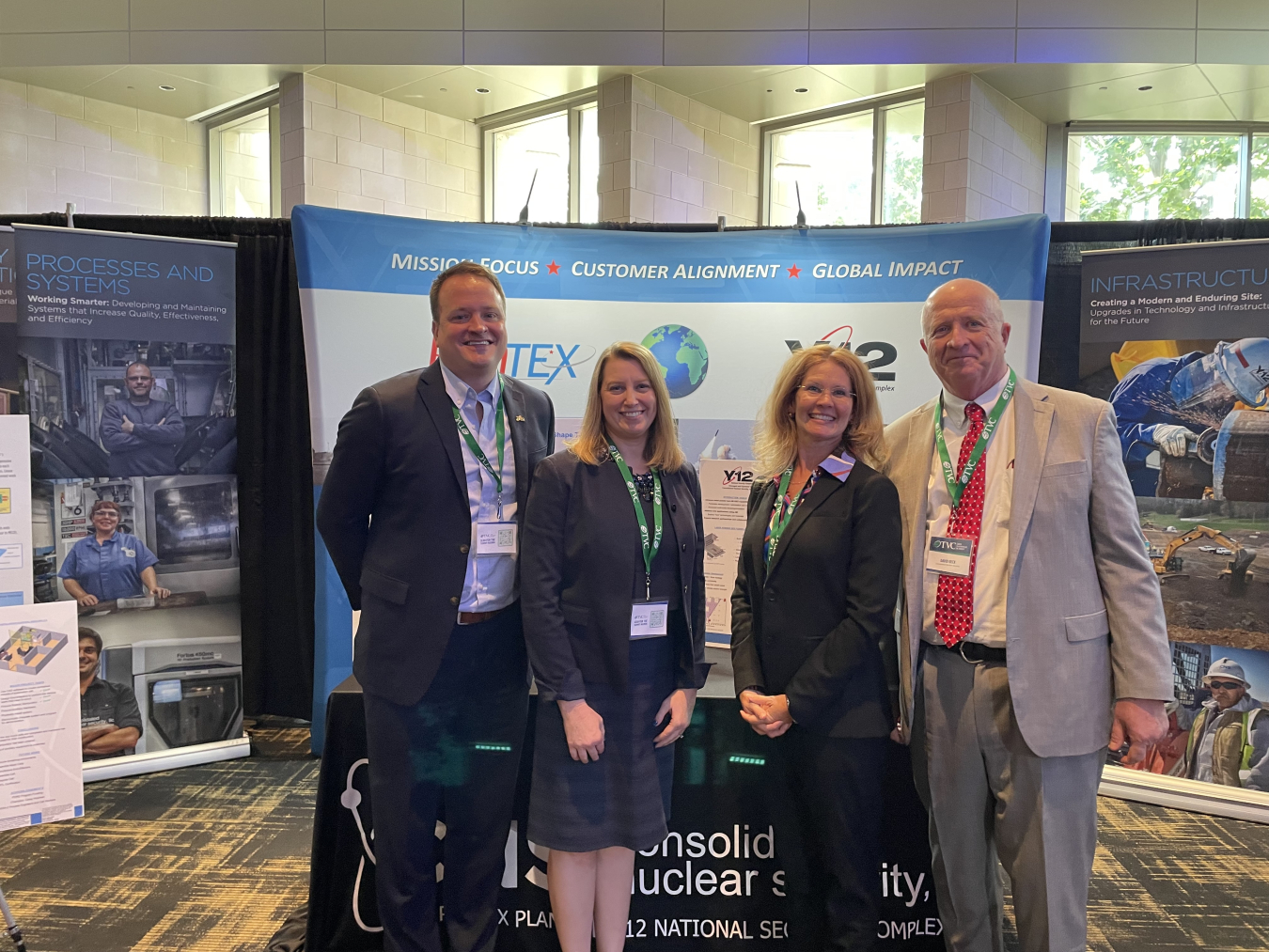NNSA Acting Principal Deputy Administrator Corey Hinderstein delivered the keynote address to open the Tennessee Valley Corridor 2024 National Summit
National Nuclear Security Administration
May 30, 2024
Good afternoon. It’s an honor to be here at the Tennessee Valley Corridor Summit this afternoon representing the Department of Energy’s National Nuclear Security Administration.
I would normally express my appreciation for the opportunity to escape from the confines of Washington, DC, but with Senator Hagerty and Representatives Fleischmann and Green here this afternoon, it almost feels as if I never left the capital.
In all seriousness, though, I would like to thank the elected officials here today for their unwavering support for the Department of Energy’s programs, including our national security portfolio.
The theme for this session is “Ensuring America’s Security and Global Leadership.” The Tennessee Valley has been at the center of the country’s security mission since the dawn of the atomic age.
Ground was broken in 1943 for the first production building at the Y-12 Electromagnetic Isotope Separation Plant, whose mission was to produce enriched uranium for an atomic bomb to help end World War II. Thanks to the dedication of the 75,000 patriots in Oak Ridge, and particularly the 22,000 workers employed at the site, uranium separated at Y-12 helped bring the scientific and engineering achievements featured in the movie “Oppenheimer” to fruition. Remember the jars of marbles in the movie, representing the progress toward enough enriched uranium and plutonium for the first nuclear weapons? Each of those symbolic uranium marbles reflected the tireless work of the Tennessee Valley.
During the Cold War, thousands of people worked at Y-12 to both build weapons components and study the effects of aging on those weapons to demonstrate their reliability to America’s leaders. After the end of the Cold War, Y-12 began the disassembly of nuclear weapons as the U.S. arsenal was reduced from over 31,000 nuclear weapons at the height of the Cold War to 3,750 as of 2020.
Today’s Nuclear Challenges
But that is the past.
Unfortunately, one need only glance at current headlines to see that – decades after the Cold War’s end – we once again face a dangerous and uncertain international environment. one in which the expansion of adversary nuclear weapons stockpiles and their delivery systems, coupled with increasing regional conflicts involving nuclear weapons states, pose significant challenges.
Even prior to its continued invasion of Ukraine in 2022, Russia was working to expand and modernize its nuclear weapons capabilities. President Putin and other Russian officials have made dangerous and irresponsible statements hinting at the potential use of nuclear weapons in Ukraine. Russia’s unprovoked invasion of Ukraine has also featured unprecedented hostilities around—and the armed seizure of—an operating civil nuclear power plant. Russia’s military attacks against and seizures of nuclear facilities in Ukraine severely undermine Moscow’s claim to be a responsible nuclear power and have been strongly condemned by the international community.
At the same time, according to the Department of Defense’s annual report on Chinese Military Power, “The PRC is investing in, and expanding, the number of its land-, sea-, and air-based nuclear delivery platforms and constructing the infrastructure necessary to support this major expansion of its nuclear forces.” If it continues the current pace of its nuclear expansion, by 2035 China will likely field a stockpile of about 1,500 warheads.
Thus, for the first time in the nuclear age, we are faced with a strategic environment marked by two near-peer nuclear competitors.
Taken together, these developments, among others I could note, make for a very complex international environment, one that is dramatically different from 30 years ago. On behalf of the United States and our allies, we must deter and, if necessary, respond to these threats, which is why NNSA Administrator Jill Hruby has observed that: “Not since the Manhattan project has there been a more challenging moment for the NNSA.”
NNSA’s Missions and Y-12
So, what is the NNSA – and TVC – role today?
Although many of you are familiar with NNSA and its predecessor agencies, for those of you who are not, the Congress established NNSA in 2000 with three enduring missions:
1. Ensuring the safety, security, and effectiveness of the U.S. nuclear weapons stockpile;
2. Reducing the threat of nuclear proliferation and nuclear terrorism around the world; and
3. Providing nuclear propulsion for the U.S. Navy’s fleet of aircraft carriers and submarines.
The work performed here is critical to each of these missions.
Last year, NNSA added more than 200 modernized warheads to the stockpile, the most since the end of the Cold War. Y-12 was key to making that happen. Today, production, engineering and development activities on six stockpile modernization programs are now underway at Y-12.
Y-12’s expertise with uranium is not limited to nuclear weapon production. For example, last year Y-12 completed 100 percent of its dismantlement and more than 100 percent of its disassembly milestones. The uranium from these dismantled weapons will subsequently be used for future weapons refurbishments and for providing enriched uranium to power the U.S. Navy, helping to enable the 78 active nuclear-powered warships of the U.S. Navy maintain their readiness and a forward presence in support of U.S. and allied security.
Indeed, the work done at Y-12 by more than 7,500 Tennesseans helps our nation to remain strong and reassures our allies.
Y-12 and Nonproliferation Work
Of course, my background is in nonproliferation, so I’m deeply familiar with Y-12’s – and Oak Ridge National Laboratory -- work in support of arms control verification, nuclear security and safeguards, and other international engagements.
Through NNSA’s Office of Material Management and Minimization, Y-12 safely removes materials from vulnerable locations internationally and transports them to Y-12 for ultimate disposition. Over the past two decades, Y-12 has removed more than 1,130 kilograms of highly enriched uranium from partner countries. Additionally, Y-12 works globally to ensure materials are appropriately protected, and in 2023 Y-12 supported NNSA’s nonproliferation work in 26 countries.
Usually, we have time to plan and execute a material removal campaign, but we have to be ready to act quickly if needed. Y-12 and Oak Ridge National Laboratory jointly maintain the capability to rapidly deploy technical experts and specialized equipment anywhere in the world on short notice to safely characterize, stabilize, package, and remove nuclear materials.
While we focus on risks, let’s not forget opportunity. Nuclear and radioactive materials serve many legitimate uses in agriculture, industry, and medicine. And of course, nuclear energy offers one potential solution to the climate crisis by providing clean energy.
These uses for nuclear and radiation technology are why more than 30 countries possess enriched uranium and separated plutonium, stored at hundreds of sites. Over 100 countries possess other radioactive materials stored at thousands of sites.
And as interest in civilian nuclear programs grows, including advanced and small modular reactors, so too does the potential for more radioactive and nuclear materials to be present in more countries around the globe. For example, at the COP28 climate talks, 25 nations signed onto a pledge to triple global nuclear energy capacity by 2050.
To achieve this future, Y-12’s work with NNSA to secure vulnerable nuclear materials domestically and internationally will remain a critical, enduring mission. Improving nuclear and radiological security not only improves the safety and security of the American people and the international community, but also creates an umbrella under which civilian nuclear research and application of nuclear energy can thrive.
Conclusion -- Investing in Y-12’s Future
I’ve recalled the past and discussed the present. What about the future? The motto of Vanderbilt University is “Crescere Aude” – dare to grow.
If there is one message I can convey to you this afternoon, it is that NNSA is committed to investing in Y-12’s future. As part of this commitment, the Uranium Processing Facility (UPF) at Y-12 is a top priority. The Fiscal Year 25 budget request for UPF is $800M, a 122% increase from the FY23 enacted budget and a 5.2% increase from the FY24 request. And I’d be remiss if I didn’t reiterate NNSA leadership’s appreciation for Congressional action to support the reprogramming of funds in FY23, to support UPF.
UPF is now over 70% complete. Gloveboxes are installed in the Main Process Building, and over 97% of all procurements have been delivered. The current focus of work is bulk electrical installation, with over 100 miles of electrical conduit and cable installed in the last year.
In addition to making progress on UPF, in late 2023, NNSA broke ground on the Lithium Processing Facility at Y-12. Lithium is a key component for nuclear weapons, which is why we have made a budget request that will enable the start of construction on this facility in FY26 and establish full capability by 2031.
Finally, and perhaps most importantly, we are investing in the people of the Tennessee Valley Corridor.
Some of you may have parents or grandparents who worked at Y-12 or Oak Ridge National Laboratory. We are committed to ensuring your children and grandchildren have the opportunity to make a similar contribution to our national security and global stability. With top-tier schools such as Vanderbilt, the University of Tennessee, Tennessee Tech, Fisk University, Auburn, the University of Alabama-Huntsville, Roane State Community College and others, the Tennessee Valley has the potential to produce exactly the kind of highly-motivated, highly-skilled scientists, engineers, cybersecurity experts, policy experts, and others we are looking for in a 21st century workforce. We are also making historic investments in our Minority Serving Institution Partnership Program and Tribal Education Partnership Programs to provide resources and outreach to students as we seek out the best and the brightest.
With the indispensable contributions of the people, institutions, infrastructure and capability of the Tennessee Valley Corridor, NNSA is protecting America’s security and demonstrating global leadership -- as we have in the past, as we do in the present, and as we will for the future.
Thank you.


